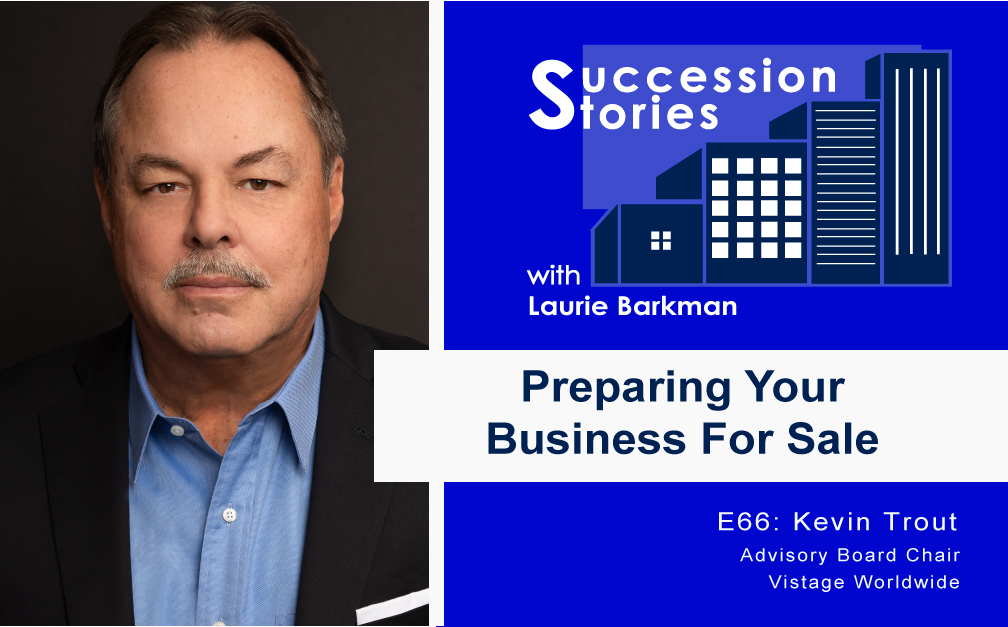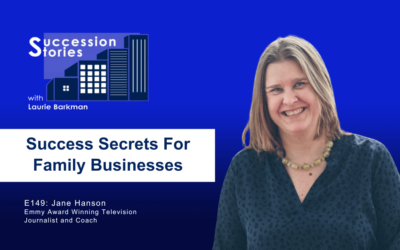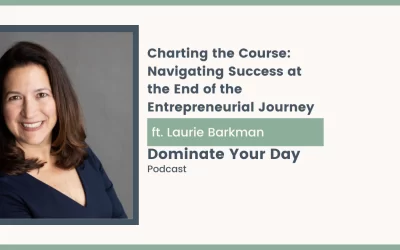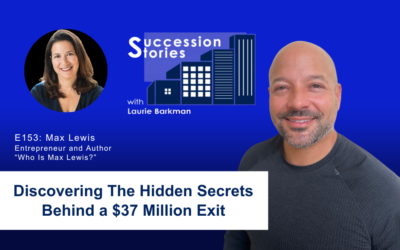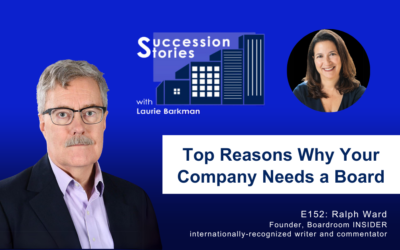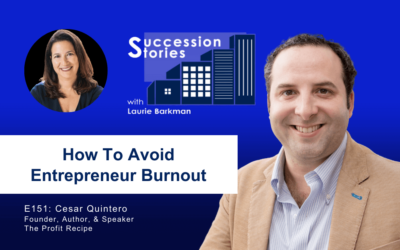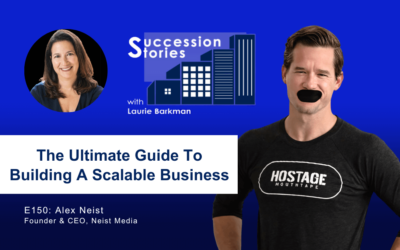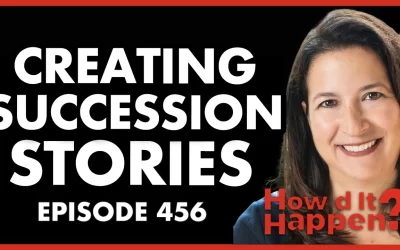How can business owners focus on enterprise value rather than short-term profits? Listen in as Laurie Barkman talks with Kevin Trout about preparing your business for sale. Kevin built Grandview Medical Resources with the intent to sell one day. Revenue growth was strong, but created too much risk in the business. Kevin shares some key decisions that he made to drive enterprise value and his reflections on what he would have done differently along the way. Today Kevin pays his experience forward as a Vistage Chair, advising high-performing executives and business owners on growing their businesses and enhancing their lives.
Listen in to learn more about:
- The importance of a Value Builder assessment in driving business value
- Phases of a business growth cycle
- How to prepare your business for growth
- Building business value beyond revenue
- Three key things to consider when thinking of selling your company
Show Links:
Three Rivers Leadership Podcast – Laurie Barkman’s appearance
Podcast website: SuccessionStories.com
About:
The Succession Stories podcast is hosted by Laurie Barkman, Founder of SmallDotBig. We’ll help you maximize business value, plan your exit transition, and get rewarded for all of your hard work by finding the right buyer or seller.
Transcript
Laurie Barkman:
Kevin Trout built his company, Grandview Medical Resources, with the intent to sell one day. Which he did in 2011 to a strategic buyer. Revenues were growing at an impressive rate, reaching nearly 30% year over year. But this pace created too much risk in the business. We talked about key decisions Kevin made to grow enterprise value rather than only focus on short-term profits. I loved our conversation about four phases of preparing your business for sale and his reflections on what he would have done differently. His appreciation for trusted advisors through Vistage was also key, and he credits them for helping maximize the value of his business. Today Kevin pays his experience forward as a Vistage Chair, advising high-performing executives and business owners on growing their businesses and enhancing their lives. Kevin’s a super guy, and I’m excited to share this episode with you.
Laurie Barkman:
Kevin, welcome to Succession Stories. I’m excited to have you here. I was recently on your radio show, and it was interesting to be on the other side of the mic. You’re here with me today, I’m really looking forward to our conversation, talking about your experience as an entrepreneur, growing your business, selling your business, and then what you do today as a trusted adviser with entrepreneurs and CEOs. So welcome to the show.
Kevin Trout:
Hey, thanks for having me. Appreciate it. Glad to be here.
Laurie Barkman:
Great. Let’s start with you. What’s your background? How did you get started in owning your own business?
Kevin Trout:
Well, short version is I fell into medical sales right after college. I was introduced to a guy from a fraternity brother and he said, “Are you a friend of Dave’s?” I said, “Yeah,” he said, “We need another guy in Pittsburgh, if you want the job it’s yours.” That was my entire interview.
Laurie Barkman:
That was the interview. That’s it?
Kevin Trout:
That was the interview.
Laurie Barkman:
“I know a guy.”
Kevin Trout:
[Laughs] Yeah. So I spent 11 years with that company and I started off doing some medical equipment service. Then four months later, they said, “Oh, you’re really good, showing the nurses how to use our equipment, we’ll just make you a sales rep.” That was my entire interview for the sales job. I became a sales rep and ended up becoming very, very successful with that company, I got promoted four times in the last five years I was with them. I was in charge of the entire east coast. By the time I left and was recruited to another company, and started the Pittsburgh Office, from scratch, built that up, then I got recruited to another company.
So I spent the first 15 years of my career working for three different medical equipment manufacturers. My last job I was in charge of, well, I had been hired to be the regional manager for this company. I had the entire eastern half of North America, Canada, through Chicago, down to New Orleans and Puerto Rico, and then they offered me the Vice President, Sales job which would be International. I said, “Okay, great.” Well, the problem was six months into that job, they said, “Oh, by the way, you do have to relocate to our home office,” which was Tulsa, Oklahoma. Like there’s nothing in Tulsa and I didn’t really want to relocate. The other companies wanted me to relocate too and I didn’t want to leave.
So by default, I ended up starting my own company in 1996 so that we could stay in Pittsburgh, and I picked up some product lines and became an independent distributor, my company was Grandview medical resources. I picked up four product lines to get started. Six months later, I had 13 product lines, because people I had worked with in the past companies, now that I started my own company, started sending their manufacturers to me saying, “You’re looking for an independent distributor. This is the guy in Pittsburgh,” and I ended up picking up a whole bunch of product lines real fast.
Laurie Barkman:
So you had a lot of experience in the industry, people knew you and that really helped you get started. So you didn’t necessarily envision yourself as an entrepreneur. You just, like you said, didn’t want to move to Tulsa, no offense to Tulsa. So that’s exciting. So the core business was medical supply distribution?
Kevin Trout:
Right.
Laurie Barkman:
Okay, gotcha.
Kevin Trout:
Especially equipment to hospitals. That was our focus.
Laurie Barkman:
Okay, so you started in ‘96, how did you grow the business? What was your strategy?
Kevin Trout:
Well, I had some particular expertise in opening new hospitals, getting into new accounts, competing against our handful of competitors. Which is why I was promoted so many times in our first company, I became a sales trainer, it was part of my role. Then the third company where I was the Vice President, Sales, they had never grown more than 10% a year. But when I came in as a regional manager, I grew the business 31% in the first year, and I was on track to grow another 36% the second year when they made me the VP of sales and said, “How do you do it?” I said, “Well, I have my way,” and so when I started my own company, I just continued to do what I was doing before and we grew very quickly. It was a great ride. I don’t know if that answered your question.
Laurie Barkman:
That’s okay. You had to focus on hospital systems in Western Pennsylvania. You had the relationships. So I’m guessing in terms of roles in the company, you were the primary Rainmaker, you were the lead?
Kevin Trout:
Yeah, I was a sales guy. I was the sales manager teaching other people how to sell. So when I started my company, I was out there face to face with all the clients, the customers, opening up new hospitals, getting them to do business with us and started to hire some salespeople and some admin and just grew the business. But I was – we were a sales organization first and foremost. That was our primary thing so we grew very quickly.
Laurie Barkman:
What were some of the main things now as you reflect back? Because you sold the company, and what year did you sell it?
Kevin Trout:
I sold it at the beginning of 2011 and then it came with a five year employment agreement, so I didn’t actually retire until 2016. So I stayed on for five years, which was way too long. But it was an earnout. So I stayed for the entire earnout.
Laurie Barkman:
How big did the company get?
Kevin Trout:
I grew my company to 14 million in sales. I had 60 employees, I had three offices. Our main one was in Pittsburgh. Then I had two satellites, one in Charleston, West Virginia, and one in Altoona, because our geography was all of Western Pennsylvania and all of West Virginia and there’s 101 hospitals in western Pennsylvania. There’s 75 hospitals in West Virginia. So our market opportunity was 178 hospitals and by the time I sold, we were doing business with 90% of them.
Laurie Barkman:
Wow. 14 million in revenue is a pretty sizable business and did you build your company with the intent to sell it?
Kevin Trout:
Yeah, I did. Actually. I never really looked at it as “Oh, this is my baby, I want to keep it forever.” I actually followed in the footsteps of the guy that hired me with that first interview. He built his company up, we were an independent distributor, he sold to one of the manufacturers, we stayed on, grew that company and then he sold it. Then he retired and he was my mentor. So I was with them through that whole journey, and I said, “If I ever get a chance to do this, now I understand how to do it.”
I didn’t realize I didn’t understand enough about how to do it. But I felt like I was along for the ride. Because he confided in me on some of the things that are going on behind the scenes that he didn’t share with other employees and so I got to watch from sitting on the bench and watching how the whole thing transpired, “So if I ever get a chance to start my own company, I think I see how this could play out,” and so that was always in the back of my mind. I figured I would sell at some point, this question of who would I sell it to, and of course the opportunity came.
One of the… it was actually the largest manufacturer that we were representing, and who was a significant portion of my revenue, they decided to roll up all their independent distributors around the country and go direct. So they were acquiring their distributors that were doing well, and was the number one fastest growing distributor. So I was number one on their hit list. Then the offices where the distributors weren’t doing so well, they just terminated their contract and opened their own office.
Laurie Barkman:
So were you contemplating a sale at that time? We call this a little Bluebird when a little Bluebird comes to you and says, “Hey, do you want to sell?” Or were you on the market at that point?
Kevin Trout:
No, I wasn’t on the market. But I knew it was coming from that manufacturer and I saw it as a strategic sale.
Laurie Barkman:
How did you know?
Kevin Trout:
Well, they approached me at one point, probably five years before I sold and said, “We are wanting to go direct, we want to roll up our distributors, we absolutely want to acquire your company when the time is right. It has to be right for you and it has to be right for us.” Well, it wasn’t the right time for a couple reasons. It just wasn’t the right time for me and for them to acquire me. So we pushed it off for five years. But that five year period it was, “Yeah, pretty sure this is what’s gonna happen.”
Laurie Barkman:
At that time, when you said you weren’t ready versus when you were ready, was the big difference between those two periods of time, do you think, for yourself?
Kevin Trout:
Just figuring out, “Okay, at some point, I’m going to sell this. What’s the right time?” Timing worked out really well for me, because I was 54 when I sold the company. I stayed on for five years and I was gonna retire at age 59. That, to me, was my ideal timeframe. So I wasn’t ready to sell, they weren’t ready to acquire everybody. They only acquired like two or three companies in that early stage, and then they waited.
Laurie Barkman:
Did you have a magic number? A lot of people use that phrase, did you have a magic number for what you wanted to sell the company for?
Kevin Trout:
I had my number that I wished I would have gotten, and then I had a number that I figured I would settle for and I wish I got a little bit more than what I was willing to settle for.
Laurie Barkman:
So was the deal based on net income EBITDA and a multiple of those?
Kevin Trout:
It was an asset sale.
Laurie Barkman:
Okay, and so what do you think would have moved the needle? I know, we have the benefit of hindsight here. What do you think would have potentially moved that needle in the multiple? I don’t know if you can share, excuse me, it was an asset sale, but how they were valuing the business versus how you were looking at it and that gap or that delta? What do you think might have changed that formula?
Kevin Trout:
Wow, great question. Because what I know now, I wish I would have known then. There’s a lot of things that I didn’t know at the time and I’m not not dissatisfied with the deal. Don’t get me wrong. I think I had a very fair deal. I could have gotten a little bit more, probably, if I would have focused on a few things. One of the challenges that I was faced with was we were growing too fast. I had a conversation with my banker, I had a million dollar line of credit and I wanted up to 1.5 million and he said, “No.” I said, “Well, we’re growing.” He goes, “Yeah, you’re growing too fast. The maximum sustainable growth rate for a distribution company is between 20 and 25% a year. And you’re exceeding that right at the moment. And so you’re too much of a risk. Because companies that grow too fast will outstrip the cash flow.” I said, “Yeah, that’s why I’m asking for my line of credit to go up.” He said, “No, you got to get control of it,” and he was right because from that point forward, I really focused on strategic growth, and intentional growth and I was able to maintain an average annual growth rate of 23% a year. I was right there in the zone.
The problem was that I already acquired some debt, in order to grow the company, I was pouring all the profits back into the company, and I was also borrowing money to build the company. Well, I didn’t, I borrowed too much and then I was too slow to pay down. I should have set some more capital aside. I was pouring every penny back into the growth of the business, I was just in a big hurry and I thought maximum value would come from the highest revenue number. The number of contracts we had with hospitals, typically, were three years worth of business. I would say that’s not enough, you’ve got to focus on a lot of other parts of the business.
What you generally point out in the value builders assessment, which I wish I would have had, showing a trend of you know, significant revenue growth is, “Yeah, you need to have that. But that’s not enough. You’ve got to have all these other things in place,” which is what I wasn’t focusing on. I was missing some things that I should have been focusing on. Had I done it differently, I would not have borrowed as much money to fund the growth of the company, I would have been more intentional, more strategic, and whatever I had, whatever I had bought, I would have paid down sooner, I would have made an intentional effort to get that down quicker. So that held things up.
Laurie Barkman:
I appreciate you sharing all that and also your your reference to this business assessment that I do with with with clients and helps them see the strengths in their business where the risks and gaps are, and also helps them see an estimate of value; how do we look at your company from the lens of a third party if they’re looking to acquire your business, because ultimately, that’s what the business is worth is in the eyes of potential acquirer and of course, this is what you’re referring to, because you saw it from their side.
Essentially, whether it’s a strategic buyer or a financial buyer, they’re looking at the predictability of your future cash flow. They’re looking at your balance sheet, they’re looking at some of those factors you mentioned. But what I love to talk about with folks, are these eight value drivers. What are the eight core things that an acquirer might look at in the business to say, “Okay, here’s some strengths. Here’s some things that might move the multiple up or might move the multiple down.” You alluded to that, so let’s spend some time on that.
As you think now back to some of the challenges, I know you and I have talked kind of offline and one of the things that we talked about was the team and having the team of people around you that were supporting you on a on a day to day basis that you weren’t the chief firefighter, and bottle washer and all of that. We call that the hub and spoke problem where an owner is in the center of everything. All the decisions are going through that person, the processes, the relationships, the key relationships. You had a team, right? You had 60 people, but at what point did you really think about this involvement for yourself? You were probably working 70 hour weeks, I’m guessing or even higher.
Kevin Trout:
I had a horrible work life balance. Horrible. Worked all week, worked all weekend. That was not fun.
Laurie Barkman:
Now, what does that do to your health?
Kevin Trout:
Wasn’t healthy. I didn’t take time to exercise, wasn’t eating right and I was always working. It wasn’t healthy. My Vistage group, they helped pull me out of that vortex, that black hole.
Laurie Barkman:
So some people might not know if they’re listening. They don’t know what Vistage is, maybe you could spend a minute on what is Vistage?
Kevin Trout:
I appreciate that. Vistage is the largest CEO peer advisory forum membership organization in the world. There’s 24,000 members worldwide in 25 countries. It’s been around since 1957. When I started my business, I was a sales guy. I was a sales manager and then I started a company and then I started hiring people and this company grew up around me. I realized, I’ve got a lot of sales experience, I don’t have a lot of CEO experience. I had some leadership experience, but didn’t have a business CEO experience. So I joined Vistage a few years into my company and became part of a Vistage group. Vistage groups are made up of business owners and CEOs. We sit in a roundtable sort of format, usually around 15 or 16 members in each group. We meet once a month, and we help each other process our toughest decisions, our toughest challenges, and we provide perspective from you know, 15 other people who sit in the same seat that we do, just in a different company or different business.
We have some subject matter expert speakers who come in and do workshops for us on leadership. It’s a great experience. You were one of my Vistage speakers and it was a great experience. For me personally, it helped me grow my business as fast as I did. They helped me sell my company, ‘cause we had an attorney in the group and he negotiated the sale for me. It was all good. Anyway, that’s what Vistage is.
Laurie Barkman:
Gotcha. So the role of advisors comes up a lot on the show. So it’s good to know that you had people who had some experience that you were relying on as you were building the company, and then when you were deciding to sell it, you also relied on them for their expertise, which is great. Vistage is definitely an organization for CEOs. Check out if you’re listening, and you want to learn more about them. I’ll also include a link in the show notes. Back to your story about selling the company and the challenges that you faced along the way. The other thing that you had mentioned to me was revenue concentration. A significant percentage of your revenue was from one of your largest clients. Is that correct?
Kevin Trout:
Yeah, by then we represented 10 different manufacturers, and the one I sold to was almost 50% of my revenue. The other nine made up the other 50%.
Laurie Barkman:
So to go to the largest concentration, for them, it was a win because they were basically buying up that market share from their competitors. That was their strategy.
Kevin Trout:
Right.
Laurie Barkman:
Yeah, that makes sense. Okay, well, this is really helpful. So what are the other things that you might reflect on if a business owner is listening, and they’re thinking about what you said about the balance sheet, about debt, about the team, and how to get more of that work life balance? What would be three things that you might give them some insights on? To say, “Okay, you really need to think about this, if you’re starting to think about selling your company.”
Kevin Trout:
Number one, I would tell them to start early. It’s never too early to start building value in your business. When I talk about building value doesn’t just mean growing revenues. It doesn’t just mean adding staff and people to your org chart. I think you really need to focus on those eight business drivers that you allude to in your value builders.
Now, I wish I would have had the value builders assessment back when I was getting ready to sell because not having that, I didn’t have an awareness of some of the areas in which I could have strengthened the company and maybe gotten a little bit more value out of it. So I missed that and I would encourage everybody to really understand what that entails and start doing it now, even if they’re not thinking about selling their business anytime in the near future. Why not build value in your company right now anyway, it doesn’t make any sense not to. So I think that’s number one.
I would also think, understand the business’s life cycle. I allude to the fact that starting a business from scratch and growing it, is like driving a manual transmission car. When you’re in first gear, you’re the owner, you start the company, your main focus is to go out and get customers and bring in revenue and everybody wears a lot of hats, even though there’s only a few people. You get to a certain point where you’ve got to push in the clutch and shift into second gear. Now you’ve got some revenue coming in, you’ve got customers, you start to add some salespeople, you start to add an office admin, you start to get a bookkeeper, whether it’s full time or fractional, you get in some of these. So the company starts to grow in second gear. Profits start to appear and they’re kinda nice in second gear. If you wait too long, to shift the clutch into third gear, what happens is, next thing you know, you have 20 people in there all reporting to the owner. That’s not sustainable long term. Leaders can only really manage maybe six direct reports. When you have 10,15, 20, now the CEO becomes the bottleneck, that owner becomes the bottleneck to that company’s growth.
That’s when you have to push into clutch and shift into third gear. Third gear is when you start to bring in some professional managers, you put a leadership team in place, and he starts to manage the different departments and so you only have your leadership team, reporting to the owner or the CEO but the leadership team manages the different departments and it allows you to grow even more, and that business owner takes one step more away from the day to day activity. He’s no longer making sales calls, but he will go out and he’ll participate in the really important sales calls with the salesperson, but he doesn’t have any of his own customers anymore. Now, here’s a trick. Second, gear profits are really nice, you’ve got a little family of employees reporting to the owner and a lot of owners don’t understand what it takes to get into third gear. Because when they start bringing professional managers profits to just disappear, and they’re definitely afraid of that, definitely afraid of giving up the profits.
But it’s necessary, because when you get to fourth gear, which I call overdrive, profits come back exponentially greater than they were in second gear, and the owner doesn’t work in the business anymore. He has a leadership team that does all the tactical work, and the owner is just a strategic visionary, and makes sure that the company is moving in the right direction. But his leadership team is responsible for all of the activities and all the tactical day to day stuff, and you hold them accountable for the profitability.
Getting to fourth gear from second gear is where a lot of business owners hesitate and I think it was a Vistage speaker that actually laid out the four phases, and I said, “That sounds to me like this,” and I’ve used that analogy ever since and it made so much sense. I actually followed that path. I gave up my profits and shifted into third gear, brought in some professional managers. I had a VP of operations, I had a VP of finance and a VP of administration. I still ran the salespeople, but I wasn’t selling to anybody directly. I was just more involved in the big deals. I couldn’t afford those people at the time, but boy did it pay off and we got to fourth gear and my life was so much easier because in fourth gear, you don’t have to work 40 hours a week. You can put in 30 and have a wonderful work life balance. That’s Nirvana. Profits are nice, that’s the time to sell which is what I did. The real trick is understanding what the four phases are, and more importantly, I think, knowing when to push in the clutch, the timing is very important. Because if you push the clutch too soon, you stall the engine. You’re spending too much money if you hesitate to push in the clutch and you wait too long. The tachometer goes in a red zone and people get burned out and the number one person that gets burned out is you the business owner. I was right there in first and second gear, I should have pushed the clutch in maybe a little sooner, but the point is I got into each of the different phases. It all worked out for me, and when I got to fourth gear profits were really, really nice. That was my best income, and I wasn’t having to work 40 hours a week.
Laurie Barkman:
That’s a great story. I love how you packaged it and it’s easy to understand, with that analogy of the car and moving it forward. A couple of things, just to underscore that you said. One was, you’re really trying to build a company that could really thrive without you, so you had the team, you were willing to sacrifice profits to build enterprise value, you had that perspective, and it did pay off. There is a difference between this profit driven mindset and we all want that especially when we think that that’s going to help build the value in the company.
But these trade offs of not hiring let’s say, the person with more expertise, who’s going to get a higher compensation package could be the wrong decision for that reason where that lower level person might not build the enterprise value for you over time, so that’s a really important thing. Then also, surrounding yourself with that team that could ultimately free you up to go do other things and enable you to fulfill your vision of building this company to sell. So I appreciate you sharing those actionable ideas.
I want to shift gears – to use that analogy – shift gears to talking about what you do today, because it’s a great segue. I obviously know you, we’ve worked a lot together and I have appreciated not only you as a colleague, but also this friendship that we’re developing. So we’ve had a lot of conversations and have gotten to know each other well. I believe in your comments – and hopefully it’s coming across – you’re a great executive coach. What have you done after selling your business? I would love you to talk about that transition, because spoiler alert, you’re a Vistage chair and you’ve now embraced this other side of working with CEOs to help them be successful. So talk a little bit about that. Why did you decide to become a Vistage chair, and what do you enjoy the most about that role?
Kevin Trout:
So I appreciate that question because I think the most fun I had as a business owner was coaching and mentoring the staff that I brought on board, especially the salespeople. I had an awesome team of salespeople, and I spent a lot of time training them and they all became super successful. They’re still crushing it out there. So they’re all doing really well. I really enjoyed the coaching and mentoring part and as I got closer to selling the business, I knew we were going to do that, “Yeah, I’m gonna retire at age 59, but what am I going to do because I don’t relax well, and everybody in my family lives to 100. So that’s in our genes so what am I going to do?”
I think working after retirement, people say, “Ah, you know, you still want to stay relevant.” I don’t think it has anything to do with ‘relevant’, I think it has everything to do with engagement. I think you have to stay engaged after retirement both physically and mentally. You have to stay physically active and physically engaged, but you also have to stay mentally engaged and I wanted to do that. So as I approached my permanent retirement, like my five year employment agreement was ending, I had some consulting firms approach me.
One was the predictive index people that do behavioral assessments and so for me, it was, “Oh, yeah. Yeah, that would be great. I could do that.” So right after I retired quickly. After that, I ended up working with predictive synergistic systems as an independent coach using a predictive index and I think I ended up with maybe 25 clients. Then soon after that, Vistage, where I’ve been a member for 16 years, approached me, “So we need more Vistage chairs,” I said, “Oh, yeah, that would be great. Because I get to give back to the community that gave so much to me.”
So in 2018, I went to the Vistage Academy in July. So it’s actually three years this month that I became a Vistage chair and so I’ve been growing the Vistage practice. I really enjoy coaching and mentoring other business owners and executives as they’re coming up behind me because, “Hey, you don’t have to make the same mistakes I did. You can learn from my mistakes,” and a lot of their experiences that they’re going through right now, I’ve already been through them. Just how to start a company was a challenge. It takes longer than you think it should, maybe three times longer than you think it should. Probably takes five times as much money as you think it should cost you then once you get it off the ground, I think you really need to understand those four phases and most business owners don’t, and then what’s it like to sell the business. I went through that. So that’s a long answer to a short question.
Laurie Barkman:
Well, it’s a full 360 and it’s, I think, a great role for you. There’s something I want to rewind on. You brought it up a couple times; you mentioned earnout. Can you explain what an earnout is and how it was structured for you for that five year period?
Kevin Trout:
Sure, the earnout is basically when I get to hold the mortgage. So they gave me a down payment, a very hefty down payment and then it was based on a five year earnout, which is why my employment agreement was five years. My particular earnout was based totally on top line revenue. I got a percentage of the top line revenue, which was my incentive to continue to grow the revenue over that five year period, because whenever the revenues went up, my monthly earnout check went up. It was a percentage of the total. I didn’t have control of the operating expenses, they did. There were a few variable ones, of course, that I was responsible for, but most of them, I didn’t have control over. So really, it was about driving revenue. That was my earnout. So I got a very hefty salary to continue to run my geographical region and I got the earnout checks every month based on the top line revenue for the month, and at the end of five years it all came to closure.
Laurie Barkman:
So when you first sold the company, then it wasn’t a 100% buyout they had reserved over the five year period. Did it equal 20% each year?
Kevin Trout:
No, it kept getting bigger as the revenues continue to grow. Each year was bigger.
Laurie Barkman:
Gotcha. There was a kicker on top.
Kevin Trout:
Yeah, it was basically top line revenue. If we were doing a million dollars, I got a percent of a million. If the next month we did 1.2 million, my percentage was the same but it was on 1.2 million, not 1 million and it fluctuated a little bit every once in a while. Numbers would go up and then come down and go up. I didn’t actually know what that final number was going to be.
Laurie Barkman:
Okay.
Kevin Trout:
When I signed up on year one, I didn’t know what the final number was going to be in year five. But I had the confidence that if it’s based on top line revenue, and we continued to grow the way we had been growing, the number is going to be pretty healthy. So really, it was negotiating the down payment that was when the negotiation came in.
Laurie Barkman:
Gotcha. Thank you for that extra explanation. So Kevin, I love to ask everyone that comes on the show if they have a favorite quote, something that inspires you about entrepreneurship or leadership.
Kevin Trout:
When I was 17, I worked for a rental company and the boss there had this one quote that I’ve been using my entire life. He said, ‘everyone’s allowed to make mistakes, you’re just not allowed to make the same ones twice,’ and I told everybody that even in my company. They thought that was my quote, they thought I came up with it, and called that one of my Kevin-isms, as they called them and that was one of their favorites. Because what it did was say, “Hey, if you make a mistake, you’re not gonna get chastised. We just have to learn from it, okay, so that we don’t do it again.” So I think everybody really appreciated the fact that they weren’t afraid to make a mistake, but guess what, we were going to have a discussion after that mistake occurred on, “What did we learn from it? How are we going to use that lesson going forward so we don’t repeat the same mistake? Let’s go forward with a new framework,” and I think everybody really appreciated that.
I would say my second quote has to do with culture, which now that I know a lot more about culture and the eight steps to create the culture you want drive it to the organization – thanks to David McLennan – I would say culture. There’s an old saying, “Revenues cure a lot of ills in a company.” I don’t think that’s true. My quote is “Revenues cures the bills, culture cures the ills.” Because if your revenues go up, and you don’t have a good culture, those problems are simply going to actually get worse as your company grows, and I think culture cures the ills within the organization. So if you have climbing revenues, and you intentionally create the culture you want, your chances of being successful skyrocket and so that’s one of my other more recent quotes that I like to use.
Laurie Barkman:
I like it, I like your modifier on that. So if people want to reach out to you, Kevin and get in touch and learn about what you do, what’s a great way to find you online? By the way, you should mention your radio show.
Kevin Trout:
Thanks, I appreciate that. So first is LinkedIn. You can find me on LinkedIn. Second, you can go to Vistage.com. I will have my own website pretty soon, then my email address is kevin.trout@vistagechair.com. I would encourage everybody to tune into my radio show. It’s on 101.5 FM, every Tuesday afternoon at 2:30 and it’s called Three Rivers Leadership. It’s where I get to interview the high performing CEOs and business owners in our Pittsburgh community and get to know their backgrounds and their leadership styles. It’s a 30 minute show and after it airs, the next day, it’ll go up on the podcast world and you can find the past episodes on podcastpittsburgh.com and when you drop down on the box of different podcasts, Three Rivers Leadership is the last one on the list.
Laurie Barkman:
Perfect. My episode will be there soon. So I’ll be sure to include that in the show links to and also on my website. Because you had mentioned the Value Builder assessment, I just want to make sure people know if they are interested in getting a complimentary assessment of your business and your strengths and your opportunities, to reach out to me for that. I’d be happy to talk with you.
Kevin, thank you so much for coming on the show today. Great lessons learned and I appreciate all your actionable ideas. Thanks again for coming.
Kevin Trout:
Hey, thanks for having me. I appreciate it, Laurie. It’s always great chatting with you and I definitely enjoyed interviewing you a few days ago for my show. Yours was one of the best interviews.
Laurie Barkman:
That’s awesome. Also, because my parents were sitting in on the interview, they were silently observing, I’m glad it went well, Kevin. Thanks again for being here.
Kevin Trout:
All right. Thanks, Laurie.

